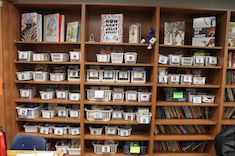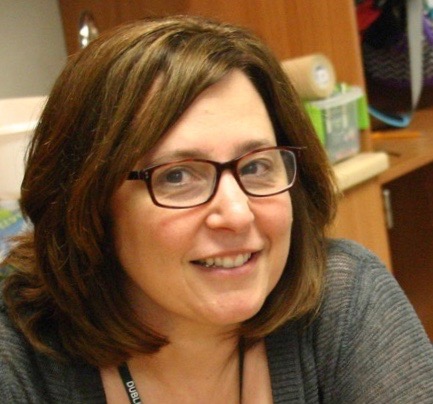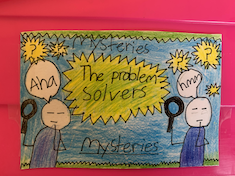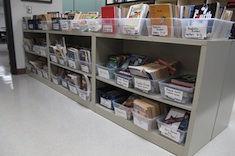If you walk past my room on many days during my planning period, you will see me standing in front of the shelves, pondering. Those are the days when I’ve come to the conclusion that I just don’t have enough books in the classroom library to meet the needs of my students. It is on those days that carefully created baskets and displays are well worn and students have run out of things to read. And very predictably as I stand in front of the shelves, I figure out how to change things up a bit to better meet the needs of the readers in our classroom. It isn’t ever that I don’t have enough books but that our library needs a freshening-up.
Our classroom library changes throughout the year, but I can never predict how it might change. We have baskets of books organized by author and series. There are spine-out books for browsing. And there are several spaces with books on display in the classroom. I find that having a variety of books on display, and changing them often, keeps the library fresh and allows kids to think beyond their comfort level as readers. At the beginning of the year, the library is set up in a way that invites lots of readers to find books they may love. But as I get to know the readers in the classroom better and as they understand they have a voice in the classroom library, the library evolves.
Many things lead me to standing in front of the bookshelves wondering what to do. Often I have noticed that several students have asked for a conference because “I can’t find anything to read.” Or maybe I’ve noticed that students who used to be engaged during independent reading time are flitting from book to book to book. Or maybe I’ve had several conferences with students who are looking for a similar type of book
This year, one of our read alouds was Refugee by Alan Gratz. This was a powerful read aloud and one that affected many of the students. Because of this book, many readers realized that they might like historical fiction, a genre they hadn’t considered for independent reading before. After a few conferences with individual students who asked for historical fiction recommendations, I realized that the whole class would benefit. So, a new book basket was created: it was labeled Historical Fiction, but I introduced it as “If you liked Refugee, you might like . . .” I added books such as The War That Saved My Life by Kimberly Brubaker Bradley, Gertie’s Great Leap to Greatness by Kate Beasley, and A Night Divided by Jennifer Nielsen to the basket.
In January, I met with a student who had fallen in love with the Land of Stories series by Chris Colfer. This was a student who had read and loved the first three books in the Harry Potter series and had (finally) discovered a series she enjoyed just as much. I immediately thought of five other students who had loved Harry Potter who might enjoy this newer series. It seemed a quick share by this student and a basket placed at student eye level on our shelf would invite other readers to try this series.
In March, a student discovered Patricia MacLachlan. He had fallen so in love with her book Waiting for Magic that he told anyone about it who would listen. Every time I’d be talking with a student and recommending possible next-reads, this student would silently slide over and add Waiting for Magic to the pile. I had several books by MacLachlan, but they were not in a basket, so I created a basket because so many readers had fallen in love with this one book.
Sometimes updating the library is merely a matter of moving a basket that many kids haven’t noticed but may be ready for. In April I noticed that one student was hooked on the author Margaret Peterson Haddix. He was practically reading a book a day in her Shadow Children series. Not many students were reading science fiction, but I knew that they would be interested in a series that they had seen their classmate reading with such enthusiasm. So, I grabbed the Haddix author basket and put it in the meeting area for a few weeks. After a few students discovered it, it made its way back to the bookshelf. Once enough students were talking about these books, I knew others would find them.
Much of keeping the classroom updated lies in knowing the books on the shelves and listening to students. When I see patterns or notice a need, standing in front of the bookshelf and reminding myself what is there in light of my new understandings is the best way I know to keep the library engaging throughout the year.






